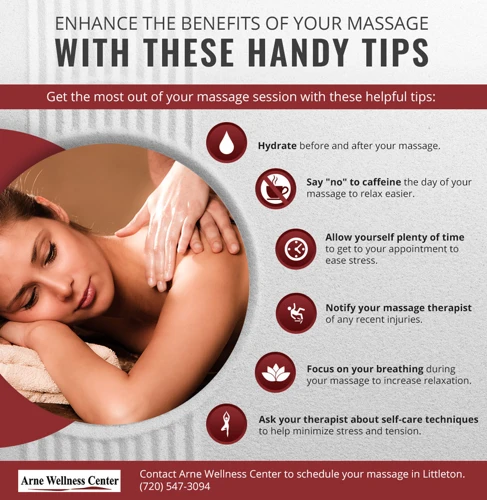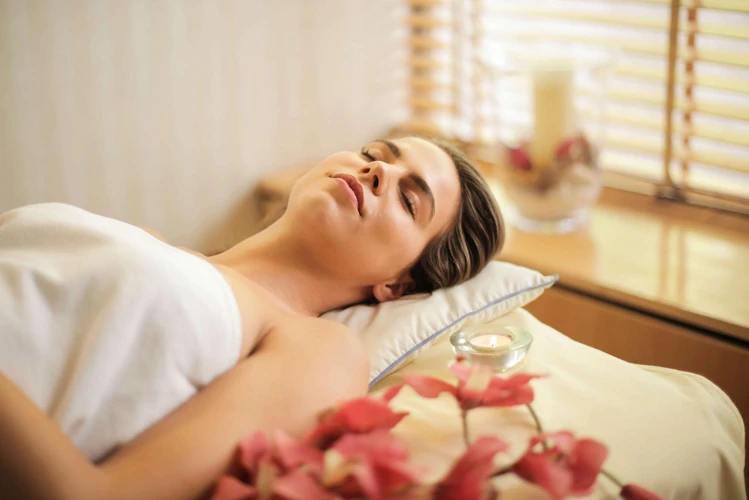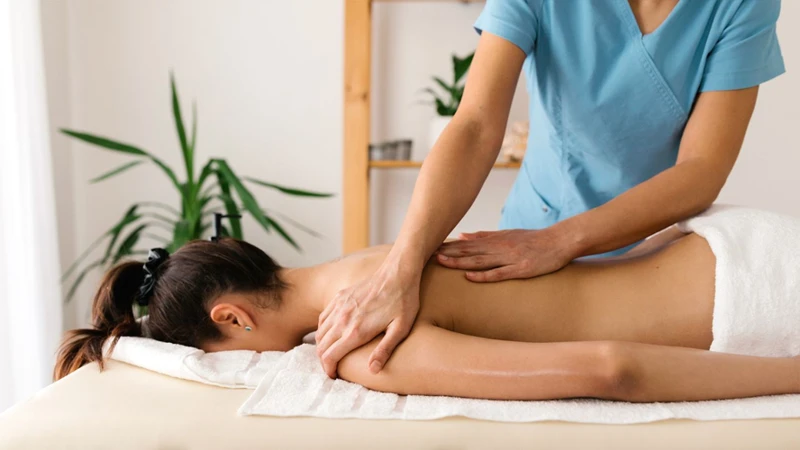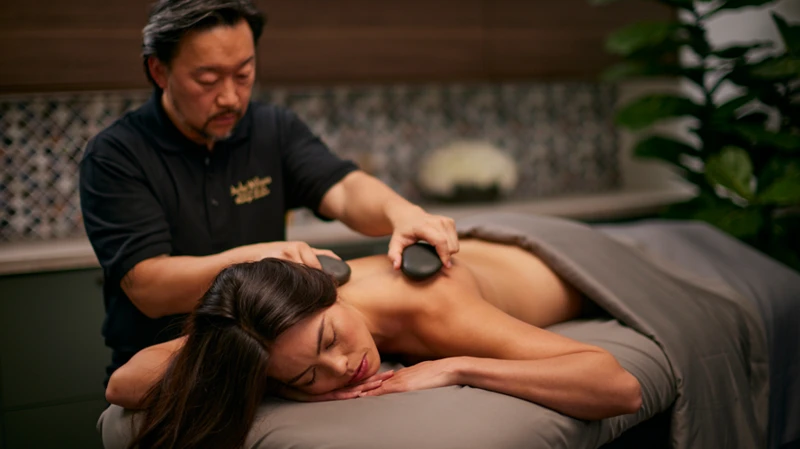Do you want to get the most out of your massage and reap the most relaxing benefits? Massage therapy can be incredibly beneficial but only if you know how to get the most out of it. Here are some tips to help you maximize your comfort and get the most out of your massage experience.
Contents
Benefits of Massage

1. Stress Relief – Massage has been proven to reduce stress, both physical and mental, by relaxing the body and calming the mind. It can also help to reduce anxiety and depression, as well as improve sleep.
2. Improved Circulation – Massage can improve circulation by increasing the flow of oxygen-rich blood to the muscles and tissues. This can help to reduce muscle tension and improve flexibility.
3. Pain Relief – Massage can help to reduce pain, both chronic and acute, by stimulating the release of endorphins, which are natural pain-relieving hormones in the body.
4. Improved Immunity – Massage can boost the body’s immunity by increasing the activity of white blood cells, which help fight off infection and disease.
5. Reduced Muscle Tension – Massage can help to relax and stretch the muscles, which can reduce tension and tightness.
6. Improved Posture – Massage can help to improve posture by releasing tension from the muscles and improving flexibility.
7. Improved Mood – Massage can help to improve mood by reducing stress and anxiety and promoting relaxation.
8. Improved Skin Health – Massage can help to improve skin health by increasing circulation, which can help to reduce wrinkles and age spots.
How to Get the Most Out of Your Massage
- Set aside enough time for your massage, so that you can relax and enjoy it.
- Drink plenty of water before and after your massage to help flush toxins from your body.
- Choose an experienced and reputable masseuse for maximum comfort and relaxation.
- Let your masseuse know about any health conditions or areas of tension that you would like them to address.
- Communicate with your masseuse throughout the session to ensure that you are comfortable and that the massage is helping to relax your body.
- Take some time to relax and unwind after your massage to get the full benefits.
Preparation for a Massage

Choose the Right Time – It is important to choose a time for your massage that allows you to be relaxed and not rushed. Avoid scheduling a massage too close to a stressful event or deadline.
Arrive Early – Arrive at least 10 minutes before your scheduled appointment to allow yourself time to fill out paperwork and get comfortable.
Choose the Right Clothing – Wear whatever type of clothing you are comfortable in. If you are getting a full-body massage, you will be asked to disrobe and lie beneath a sheet on the massage table. Your therapist will leave the room while you undress and give you privacy to get on the table face down.
Communicate Your Needs – Before the massage begins, tell your therapist about any problem areas that need attention and any areas that should be avoided.
Stay Hydrated – Drink plenty of water before and after the massage to help your body flush out toxins released from the muscles during the massage.
Choosing the Right Massage
- Types of Massage: There are many types of massage, including Swedish massage, deep tissue massage, sports massage and aromatherapy massage. Choose a massage that best suits your needs.
- Experience: Massage therapists have different levels of experience and training. Make sure to ask about the therapist’s credentials and training before selecting a massage.
- Location: You can get a massage at a spa, a massage clinic, or even in your own home. Choose a location that is comfortable and convenient for you.
- Equipment: Different massage therapists may use different types of equipment. Make sure to ask what type of equipment the therapist is using before booking a massage.
- Timing: Massage sessions can range from 15 minutes to 90 minutes or more. Choose a session length that best fits your needs and allows for enough time for relaxation and enjoyment.
Setting the Ambiance

- Essential Oils: During the massage, use essential oils to create a calming environment. Choose oils like lavender, rose, or jasmine, all known for their relaxing and calming effects.
- Soft Music: Set the mood by playing some soothing music in the background. Instrumental music or nature sounds are great choices.
- Low Lights: Dim the lights in the area to create a relaxing atmosphere. This will help you feel more comfortable and relaxed.
- Comfortable Temperature: Make sure the temperature in the massage room is comfortable. If it is too hot or too cold, you won’t be able to fully relax.
Choosing the Right Massage Therapist

- Research: Take the time to research massage therapists in your area. Check reviews and credentials to make sure the therapist is experienced and reputable.
- Experience: Ask potential massage therapists about their experience and the types of massage they specialize in. Choose a therapist who has experience in the type of massage you’re looking for.
- Certification: Make sure your massage therapist is certified and licensed. Ask to see proof of certification and license before making a decision.
- Location: Consider the location of the massage therapist. It’s important to choose one that is convenient for you so you can make your appointments without having to travel too far.
- Communication: It’s important to have open communication with your massage therapist. Talk to them about your goals and expectations before starting your treatment.
Selecting the Right Massage Oil

- Choose an oil that has a consistency and texture you find comfortable: Massage oils can be either very light or very greasy, so select one that feels good to you. Some oils can be too thick or too runny, so it’s important to find the one that you find comfortable for your massage.
- Opt for natural, organic oils: Massage oils that are made from natural and organic ingredients are ideal since they’re free from harsh chemicals and artificial fragrances. Natural oils are also much better for your skin and will leave your skin feeling soft and smooth.
- Keep allergies in mind: If you have sensitive skin, it’s important to select a massage oil that won’t irritate it. Look for hypoallergenic oils that are free from fragrances, dyes, and parabens. It’s also a good idea to do a patch test on the inside of your arm before using it on your entire body.
- Select an oil that complements your massage technique: Different massage techniques require different types of massage oils. For example, if you’re doing a deep tissue massage, you should opt for a massage oil that has a thicker consistency. On the other hand, if you’re doing a Swedish massage, you should select an oil that has a lighter texture.
Techniques for Maximum Comfort

- Communicate your needs: Before your massage session, let your therapist know about any specific areas of discomfort you have, such as lower back pain or tight shoulders. It’s also important to let them know if you prefer a softer or firmer massage.
- Stay hydrated: Drink plenty of water before and after your massage to help your body flush out toxins.
- Warm up: Take a hot shower or bath before your massage to help your muscles relax.
- Keep comfortable: Make sure you are as comfortable as possible. Consider bringing a pillow or blanket to help you get into the right position.
- Focus on breathing: Deep breathing during a massage can help your body relax and release tension.
- Avoid distractions: Turn off your phone to avoid any potential distractions. Focus on the sensations of the massage to get the most out of your session.
Aftercare Tips
Stay Hydrated: Drink plenty of water after your massage to help your body flush out toxins that were released during the massage.
Keep Moving: Don’t sit or lie down for too long after a massage. Get up and move around to help your body adjust.
Follow Up with Self-care: After a massage, you need to take care of yourself. Have a warm shower, use a foam roller, do some stretching or yoga, and take part in activities that will help you relax and destress.
Listen to Your Body: Pay attention to how your body feels after a massage. If you feel any pain or discomfort, don’t hesitate to contact your massage therapist.
Avoid Stressful Activities: After a massage, it’s best to avoid stressful activities or any activity that puts too much strain on your body.
Frequently Asked Questions
What should I do to prepare for a massage?
- Cleanse Your Body – Take a warm shower or bath prior to your massage to help relax your muscles and open your pores. If you are unable to shower, it is important to make sure you are clean and comfortable for the massage.
- Choose Loose-Fitting Clothing – It is best to wear loose-fitting clothing to your massage appointment. This will allow you to move more freely while lying on the massage table and it will also make it easier for the massage therapist to access your body.
- Eat Lightly – Don’t eat a large meal right before your massage. Eating a light snack will provide you with the energy you need to relax during the massage.
- Drink Plenty of Water – Before and after your massage, it is important to stay hydrated. Drinking plenty of water will help your body flush out the toxins released during the massage.
- Be On Time – Arriving late to your massage appointment can reduce the amount of time you will have for your massage. It is a good idea to arrive a few minutes early to ensure you have enough time to get comfortable and relaxed.
- Communicate With Your Massage Therapist – Before your massage begins, take a few moments to communicate with your massage therapist. Let them know what areas of your body need special attention and if you have any particular sensitivities.
How Long Should I Plan to Stay for a Massage Session?
Most massage therapists recommend a session of at least 60 minutes for maximum relaxation benefits. However, shorter sessions of 30-45 minutes are also available and can be just as beneficial. Consider your personal needs and the type of massage you’re receiving when deciding how long to plan your massage session for.
What should I wear to get the most relaxing benefits from a massage?
For maximum comfort and relaxation during a massage, it is recommended to wear comfortable, loose-fitting clothing. Avoid wearing items that are too tight or restrictive, as this will limit your range of motion and make it difficult to breathe. If you are wearing a swimsuit or underwear, choose something that is not overly tight. It is also important to ensure that your skin is exposed so that the massage therapist can access the areas they need to work on. Make sure to bring a towel to cover up when necessary.
Are there any specific massage techniques that are especially relaxing?
Different massage techniques offer different levels of relaxation. Swedish massage is known for its long, gentle, and rhythmic strokes which help to reduce stress and tension. Deep tissue massage is a more intense massage technique which helps to release deep-seated muscle tension. Shiatsu massage is a Japanese technique which uses pressure points to target specific areas of the body. Hot stone massage uses heated stones to help relax the body and mind.
What are some helpful tips for maximizing comfort during a massage?
- Choose the Right Massage Therapist:
-
- It is important to choose a massage therapist that you are comfortable with. Look for a massage therapist who has a good reputation and is experienced in the type of massage you are looking for.
- Choose the Right Massage Technique: Different massage techniques offer different levels of relaxation. Make sure to research the different massage techniques and find the one that best suits your needs.
- Prepare for the Massage: Before your massage, make sure to wear loose-fitting clothing, drink plenty of water, and avoid eating a heavy meal. This will ensure that your muscles are relaxed and ready for the massage.
- Discuss any Medical Conditions: Be sure to inform your massage therapist of any medical conditions or allergies you may have. This will help them adjust the massage to fit your needs.
- Communicate with your Massage Therapist: During the massage, communicate with your massage therapist if you find the pressure too intense or if you have any areas that are particularly sensitive. This will help the massage therapist adjust the massage to provide the most comfort.
- Relax and Breathe: Don’t forget to relax and breathe deeply during the massage. This will help you to get the most out of the massage and maximize your comfort.
Conclusion
Getting the most relaxing benefits from a massage requires proper preparation and following the massage therapist’s instructions. It is important to be relaxed and comfortable, so be sure to choose the right massage technique and atmosphere to suit your needs. You can also use some simple tips and tricks to make your massage more enjoyable and relaxing. With the right preparation and the right massage therapist, you can enjoy a calming, restorative massage experience.

